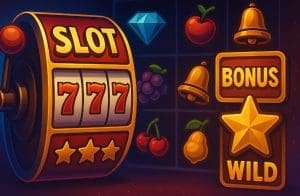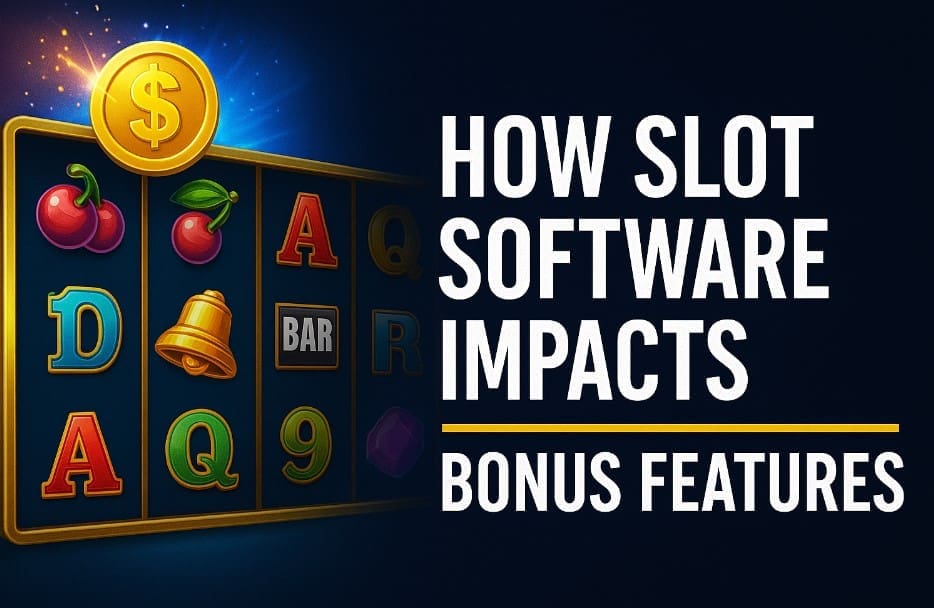Slot machines might look like a simple recipe of spinning reels and flashing animations, but the real flavor of the game comes from the software. The code tucked away behind the graphics is what decides whether you’re suddenly swept into a free spins round or watching an expanding wild crawl across the screen. Without that software magic, all those jaw-dropping features we talk about at casino bars or in group chats wouldn’t exist at all.
I still remember the first time I sat in front of a NetEnt slot that had walking wilds. I thought my screen had glitched when the symbol started wandering from reel to reel. That wasn’t luck — that was software design, pure and simple.
Why Software Shapes the Bonus Experience
Sure, RNGs (random number generators) keep things fair, but fairness doesn’t keep you leaning forward in your chair. What does? The way software turns basic mechanics into events. Cascading reels, Hold and Win bonuses, surprise multipliers — they’re all results of a developer asking, “How can we make this moment more exciting?” and then coding the answer.
Think of two kitchens. One chef has an old stove and a dull knife; the other has a state-of-the-art oven, sharp Japanese steel, and a pinch of creativity. Both can cook chicken, but one will leave you with a dry piece of meat, while the other serves up a dish you’ll rave about. Slot software providers are those chefs. Same base ingredients, completely different experiences.
Core Functions of Slot Software in Bonus Mechanics
Feature Triggering Technology
Every slot bonus starts with a trigger. Maybe it’s three scatters lining up just right, or a cheeky random event that comes out of nowhere on a sleepy spin. The tech decides how that happens. Some providers go for pure unpredictability, while others balance randomness with probability. Ever had that uncanny feeling that a bonus round is “just around the corner”? That’s software teasing you with probabilities, not a sixth sense.
RTP, Volatility, and Bonus Balance
A slot’s Return to Player (RTP) and volatility aren’t just numbers on a fact sheet — they’re the bones of the bonus system. High-volatility games make you wait, sometimes painfully, but when the bonus finally lands it feels like fireworks at midnight. Low-volatility titles, on the other hand, drip-feed small bonuses to keep the vibe upbeat. Developers use software like a mixing board, adjusting the dials so that one game plays like a rollercoaster and another like a gentle riverboat ride.
Leading Slot Providers and Their Unique Bonus Features
NetEnt, Microgaming, and Playtech Innovations
NetEnt has always felt like the quirky innovator at the party, slipping interactive bonus rounds into their slots that feel almost like mini video games. I remember hitting a feature in “Dead or Alive 2” where wilds stacked in free spins and I genuinely forgot I was spinning reels, not playing a shootout. Microgaming, meanwhile, is the king of progressive jackpots. Their Mega Moolah network is basically the lottery of slots, linking thousands of casinos in one giant prize pool. Playtech leans on licensed slots — think superheroes or blockbuster movies — layering bonuses with storytelling. Sometimes it’s not even the payout that excites you, but seeing your favorite film character animate across the reels.
Newcomers: BGaming, Push Gaming, and Blueprint
BGaming is like the minimalist who shows up with the newest tech. They emphasize provably fair gaming and mobile-friendly code, so their bonuses often feel clean and accessible. Push Gaming? They’re the daredevils. Titles like “Jammin’ Jars” introduced cluster pays and multipliers that snowball out of control in the best way possible. Blueprint Gaming often feels like the slot equivalent of a jam-packed carnival ride — cascading reels, bonus buys, quirky add-ons — all thrown in, but somehow it works.
Key Types of Bonus Features Enabled by Software
 Cascading Reels and Hold & Win
Cascading Reels and Hold & Win
Cascading reels are a simple idea on the surface — symbols disappear, new ones fall. But when you’re in the middle of one of those chains and every drop feels like a mini drumroll, you realize the coding behind it is keeping the pace alive. Hold and Win mechanics are a more recent craze. The first time I played one, I thought the screen had frozen because the symbols locked in place. Then the respins kicked in and I was sweating every empty reel, hoping to fill the grid. That suspense? That’s software orchestrating tension, frame by frame.
Expanding Wilds, Multipliers, and Bonus Buys
Expanding wilds are like an overachieving guest who won’t sit quietly at the party — suddenly they stretch across the whole reel and everyone pays attention. Multipliers are sneakier. Sometimes they’re a modest 2x, other times they stack into absurd territory. Bonus buys are a bit of a love-it-or-hate-it deal. Some players like skipping straight to the action, while others feel like it ruins the rhythm. But whether you’re for or against, it’s all possible because the software is built with that shortcut baked right in.
The Role of Software in Game Fairness, Mobile Play, and Player Engagement
Fairness is non-negotiable. Regulators audit slot software to make sure advertised RTP matches reality and random triggers aren’t skewed. But fairness doesn’t mean boring. Developers sneak in tiny flourishes — like animations on near-misses — to make the wait less painful. On mobile, it’s a different game altogether. A feature that looks majestic on a desktop can feel cramped on a phone unless it’s recoded. The smartest providers build bonus features with touchscreens in mind, making sure swipes and taps feel natural. I’ve had sessions where a bonus felt better on mobile simply because it was designed with a thumb, not a mouse, in mind.
How Players Can Choose the Best Slot Providers for Features
One of the simplest “life hacks” in slot play is learning a provider’s style. If you see Pragmatic Play, you can almost bet there’s a bonus buy. Yggdrasil? Expect something experimental like Splitz or GigaBlox. It’s like recognizing a director’s style in film — once you know it, you can predict the kind of twists to expect.
Here’s a quick mental checklist I use when deciding if a slot’s features are worth my time:
- Does the RTP and volatility fit my mood — slow burn or big swings?
- Are bonus buys available, and do I actually want them?
- Is the provider one that prioritizes creative mechanics or sticks to classics?
- How does the slot feel on mobile — cramped or smooth?
Sometimes I pick wrong and end up in a game that bores me after 20 spins, but other times I hit a match and it feels like finding a new favorite band.
Where Slot Bonus Technology is Heading
The future of slot bonuses looks like personalization. Developers are tinkering with adaptive bonuses that adjust frequency based on how long you’ve been playing. It’s partly about responsible gaming, partly about keeping players entertained without burning them out. I wouldn’t be surprised to see more mashups — Hold and Win mixed with multipliers, cascading reels paired with progressive jackpots. The industry loves a remix.
Gamification is another direction. I’ve already seen slots with mission-style challenges, where completing tasks unlocks bonus events. Suddenly, you’re not just spinning; you’re playing an ongoing story. It’s like turning slot sessions into episodes of a show you keep coming back to. All powered, of course, by software running quietly behind the curtain.


